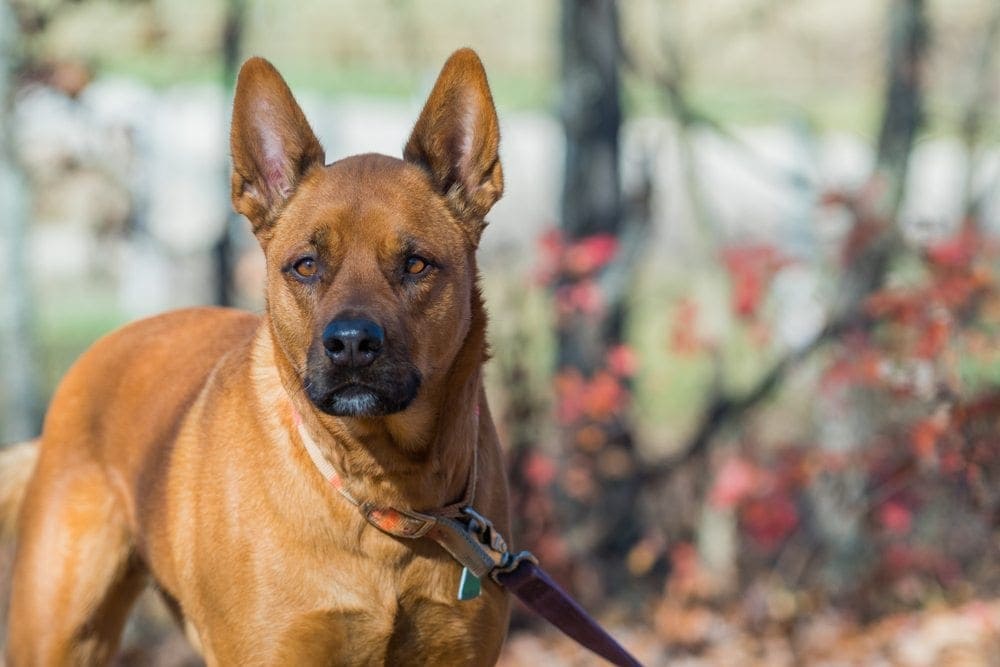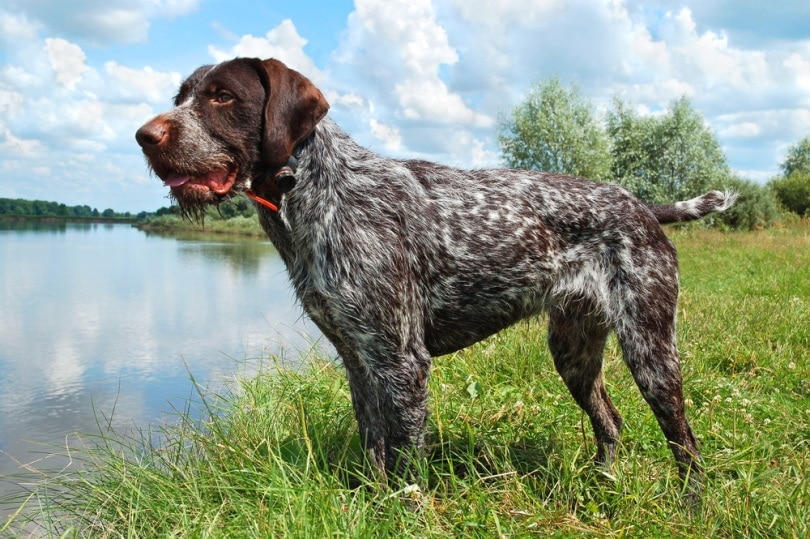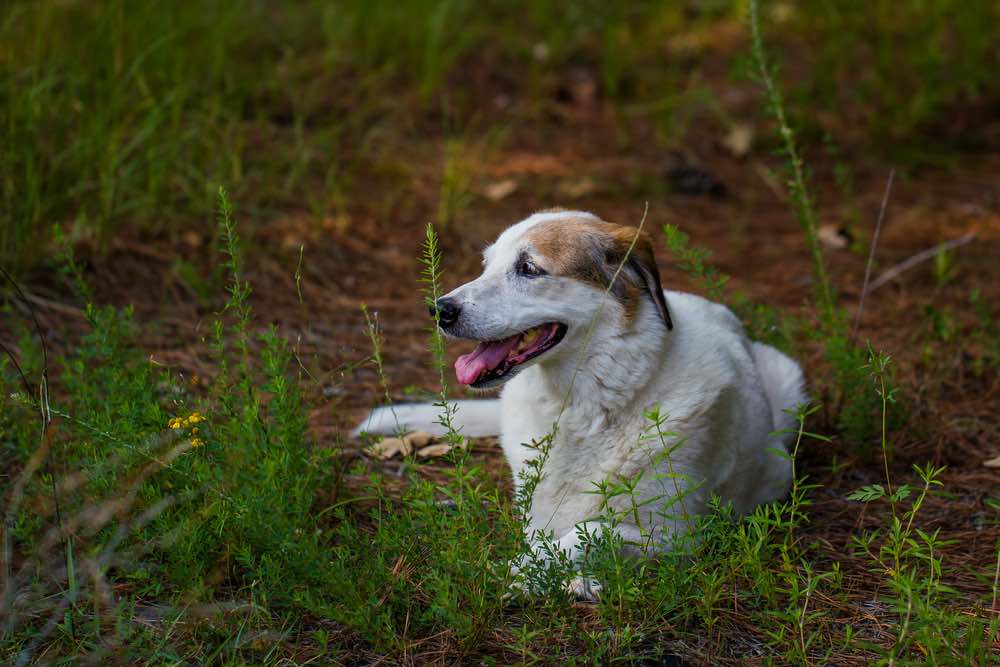Pyrenean Mastiff Dog Breed Info: Pictures, Facts, Traits, Personality

Updated on
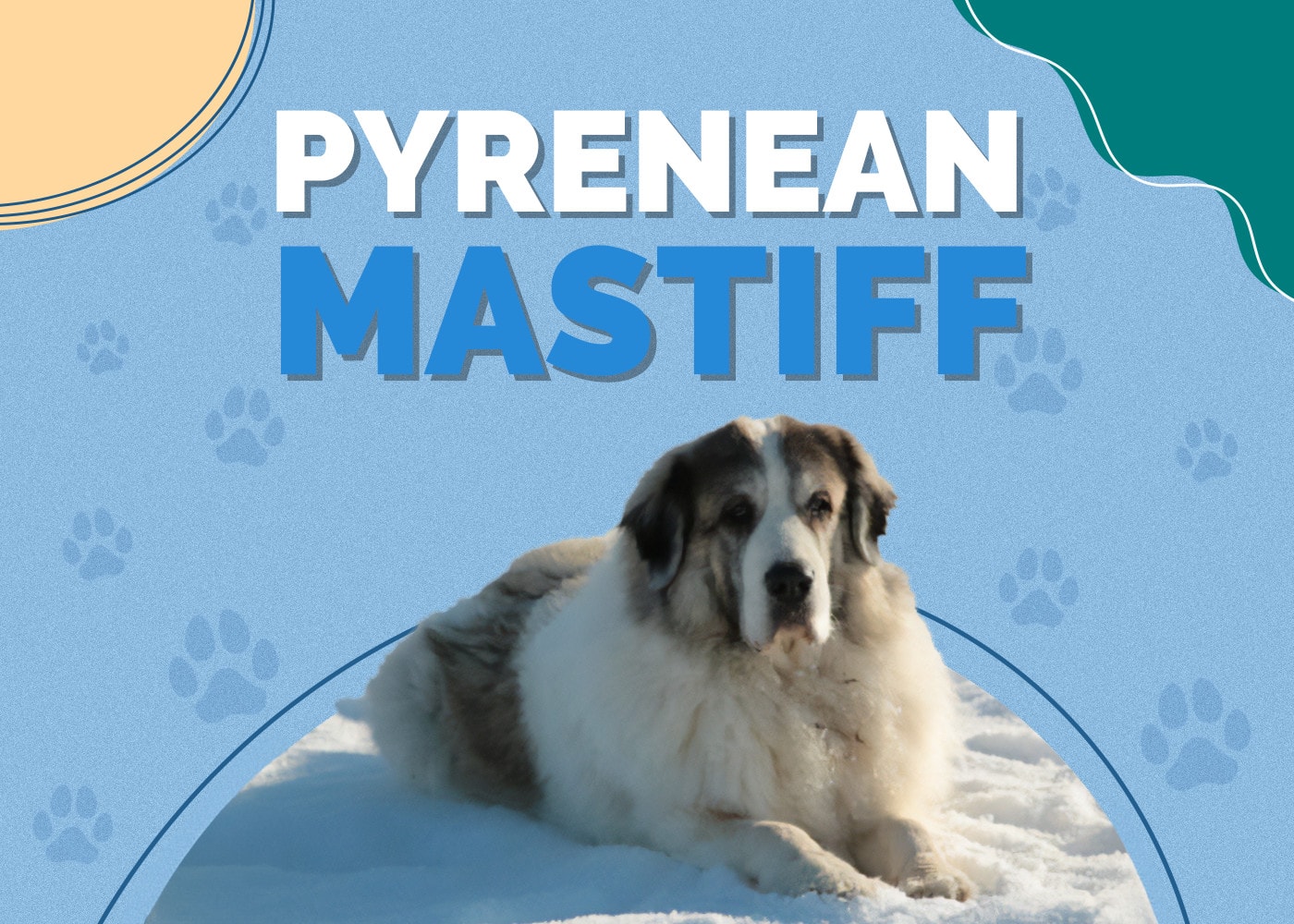
Height:
25-34 inches
Weight:
120-240 pounds
Lifespan:
10-13 years
Colors:
White with black, brown, gold, gray, silver, sable merle, beige
Suitable for:
Individuals and families with experience owning dogs and space for a big dog, households with other pets, experienced dog owners
Temperament:
Loyal, Protective, Brave, Gentle, Calm, Noble, Intelligent, Independent
With specimens as large as 240 pounds and standing nearly three feet tall at the shoulder, the Pyrenean Mastiff is one breed that certainly qualifies as massive. If it stands on its back legs, you’ll probably be looking up at it a full head and shoulders above you. You’d be forgiven for mistaking it for a bear.
Speaking of bears, these big dogs were expected to fend off bears and wolves as well. This is where they get their fierce guardian instincts; from guarding flocks of sheep and other livestock in the Pyrenees mountains.
This is what they were bred for, and were very successful at, in the kingdom of Aragon in what is now northern Spain, way back in the 1200s.
This breed was essentially locked away from the world until the late 1970s when it was finally exported from the Aragonese Pyrenees region of Spain.
Despite the large size of this breed, they’re known for being light on their feet. This trait is likely from the generations that worked all day long tending and protecting flocks from predators. Because of this past, Pyrenean Mastiffs today still do best when given some type of job to perform that will help them to expend all of their extra energy.
Pyrenean Mastiff Puppies

Because this breed is still mostly localized to just one region of Spain, Pyrenean Mastiff puppies can be difficult to obtain. You’ll want to do plenty of research on your breeder. Since they’ll most likely be located in Spain, it might be difficult for you to do any in-person research ahead of time, so read as much as you can online. Find reviews and read testimonials from people who have purchased puppies from that breeder before.
Once you find a breeder and have a puppy arranged, you’ll need to pay for any shipping costs to get the dog to you. This might involve getting a permit to import the dog, vaccinations, and other fees or regulations that must be met. In many cases, you’ll need to fly to the breeder and get the dog yourself. In such instances, you’ll need to account for the cost of international air travel when budgeting for your Pyrenean Mastiff.
3 Little-Known Facts About the Pyrenean Mastiff
1. They Drool… A Lot
This isn’t a trait that’s exclusive to the Pyrenean Mastiff but common to all Mastiffs in general. They drool an incredible amount! It’s worst in the heat, when food is present, or after drinking water.
These dogs have giant heads and big old mouths that fill that big head up. That’s a lot of surface area for producing saliva. If you’re going to add one of these giants to your family, you’ll want to keep a mop around for all the extra puddles you’ll find around your home!
2. There Are Three Classifications of Pyrenean Mastiff
This breed is divided into three distinct classifications that designate what the dog is best used for. The three classifications are working quality, show quality, and breeding quality.
Naturally, breeding quality dogs are best for breeding. They’re on the more expensive side of things and might be hard to find but they also have great genetics and proven bloodlines.
Working quality dogs are hard-working, intelligent, and make excellent companions. But they’re not the most beautiful of specimens and wouldn’t do well in a show ring.
Of course, show quality dogs are beautiful with excellent symmetry and perfect coats that make them great candidates for showing.
3. Pyrenean Mastiffs Have A Low Prey Drive
Because they were bred for protecting livestock, the Pyrenean Mastiff couldn’t have a high prey drive. If they did, they’d be a liability instead of an asset. But they made excellent protectors because they didn’t attack the livestock.
Though they may be large, Pyrenean Mastiffs aren’t aggressive unless provoked. They won’t chase after smaller animals. In fact, they’re known for playing very gently with smaller animals, showing awareness of their massive size.
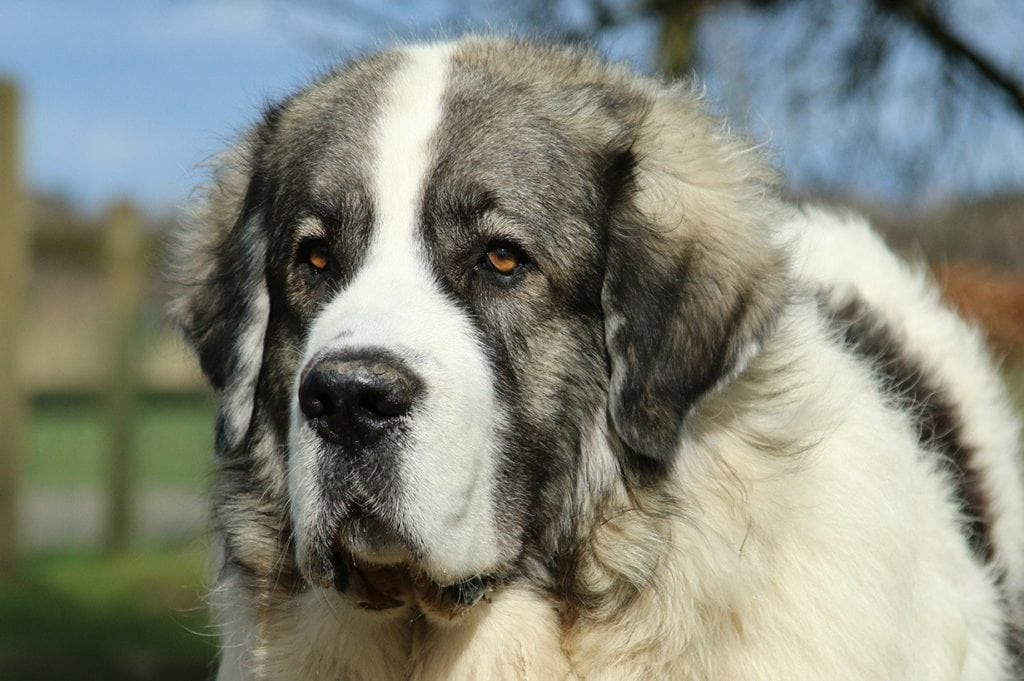
Temperament & Intelligence of the Pyrenean Mastiff 🧠
The Pyrenean Mastiff embodies the term “gentle giant.” They’re massive dogs, but they’re very gentle and sweet as well.
They’re known for being utter teddy bears with their family members. But if you provoke one of these giants, expect to see the bear-fighting guardian come out. You don’t want to be on the wrong end of a Pyrenean Mastiff that thinks it’s defending its family from harm.
But more than just gentle, these dogs are highly intelligent. Unlike many large dogs, this breed seems to understand its large size and takes account of it. You’ll see Pyrenean Mastiffs playing gently with other animals and children.
Though they’re great guardians, your Pyrenean Mastiff won’t be a barker. They might not even bark to alert you of danger, but they will find another way to let you know.
Are These Dogs Good for Families? 🏡
Because of how gentle they are with those smaller than themselves, Pyrenean Mastiffs make excellent family pets. They play very gently with children. But due to their large size, they can still be a hazard around unstable kids or the very young.
This breed also needs quite a bit of exercise. They’re not overly energetic by any means, but they have all-day work endurance and need an outlet. A big yard will give them space to run around and several walks with different family members each day can help.
Because they have such strong guardian instincts, the Pyrenean Mastiff is one of the best guard dogs around. They’re also big and strong enough to really protect your family if a situation should occur. But few people would knowingly mess with an animal that’s large enough to successfully fight off a bear!
Does This Breed Get Along with Other Pets? 🐶 😽
For most big dog breeds, their innate prey drive makes them unsafe to be kept around smaller pets unsupervised. But that’s not the case with the Pyrenean Mastiff who has a very low prey drive since they were bred to protect livestock.
This means that they do very well with other pets, even ones that are much smaller. They have been known to play very gently with smaller dogs, so they’re a great choice for families with multiple pets.
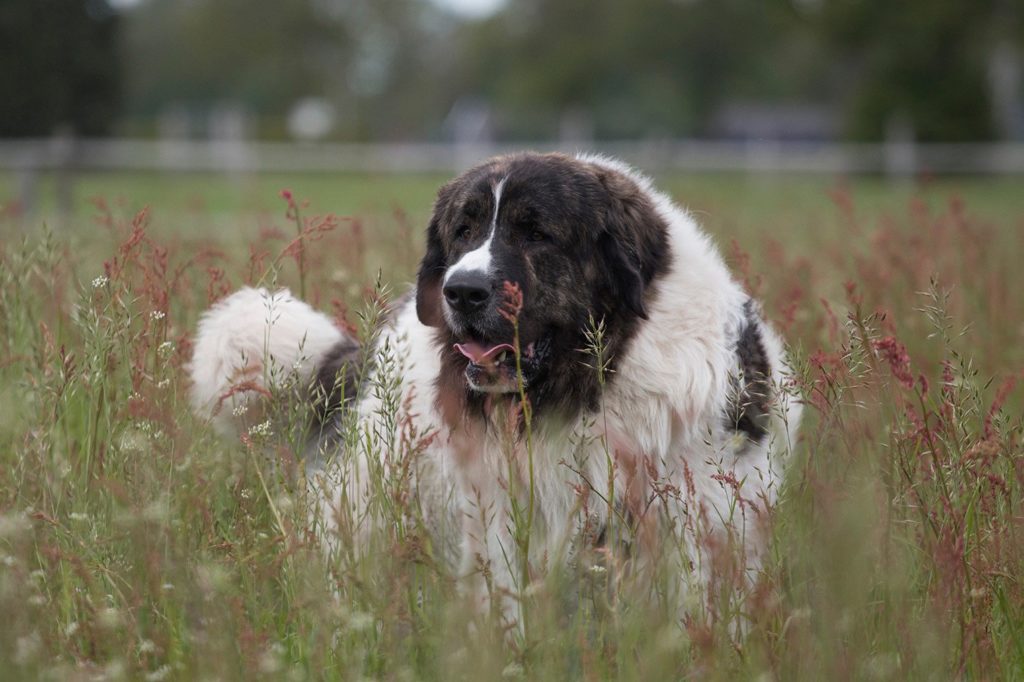
Things to Know When Owning a Pyrenean Mastiff:
Food & Diet Requirements 🦴
When it comes to feeding, the thing you have to keep in mind with this breed is its massive size. You can expect to feed your Pyrenean Mastiff three cups of high-quality dry dog food each day as a minimum. If you have one of the behemoth-sized Pyreneans, then you might be feeding even more than this.
But you’ll want to pay attention and make sure you’re feeding your Mastiff the right amount. Even though they’re gigantic, Pyrenean Mastiffs can still become overweight and even obese if you feed them too much regularly.
It’s recommended that you supplement your Pyrenean Mastiff’s diet with joint supplements. Dogs of this size are at greater risk for developing joint problems, and a regular dosage of supplements like chondroitin and glucosamine can help.
Exercise 🐕
As a dog that was bred to work all day, Pyrenean Mastiffs have tons of endurance and all-day energy. Because of this, they need plenty of exercise. The last thing you want is a dog this size turning destructive because they got bored.
Your Pyrenean Mastiff will likely need about an hour of exercise each day. This could be two walks of thirty minutes or an hour of fetch. Either way, 60 minutes each day should be the sweet spot.
On top of this, you’ll need to provide plenty of space for this big bear of a dog to run around. Big, fully fenced in yards are best for this breed so they can expend their energy to their heart’s content.
Still, one of the best ways to provide plenty of physical activity for your dog is to give it some sort of job. Pyrenean Mastiffs thrive when they’re given a job to perform and this will not only help to stimulate them physically but mentally as well.
Training 🦮
A smart breed with a long history as a working dog, you might expect Pyrenean Mastiffs to be easy to train. While they certainly have the intelligence and aptitude for it, they have enough of a stubborn streak that they can be a bit difficult to train.
This is even more true when it’s a novice attempting to train them. The massive size of this dog is often more than a novice trainer can handle when the dog decides it’s had enough.
But with a firm hand and some experience and know-how, a Pyrenean Mastiff can become a well-trained animal that does well in many environments. They were bred to work, so they can definitely still learn new tricks if you have the patience to teach it to them.
Grooming ✂️
If you’re looking for a dog with easy maintenance that doesn’t shed much, you’ll need to look elsewhere. The Pyrenean Mastiff has a very thick, long, and shaggy coat that needs continuous maintenance.
To keep the coat free of dead hair and prevent matting and tangling, you’ll need to groom your Pyrenean Mastiff with a metal comb or pin brush. You might even need a detangling spray to get the job done.
For a working dog or family companion, this will need to be performed at least once or twice each week. If you want to use your dog for showing, you can expect it to need grooming three or even four times weekly.
This breed sheds year-round. You won’t escape it. Regular grooming will help, but you won’t ever eliminate the constant shedding.
You’ll also need to trim the hair between your Pyrenean Mastiff’s footpads. But you won’t need to bathe them often; a few times a year should suffice.
Health and Conditions ❤️
Many breeds that are near the size of the Pyrenean Mastiff are plagued with a myriad of health problems. But this breed only faces a few commonly experienced health concerns.
This is partly due to the fact that the breed hasn’t been heavily popularized, so they’ve never been too heavily bred.
Still, there are a few health conditions that you’ll want to watch out for with the Pyrenean Mastiff.
Hip dysplasia: This condition is especially common in the largest dog breeds. It can range in severity from mild to crippling. There’s no cure for it but treatment and pain management can offer a dog with hip dysplasia comfortable living for years.
Hip dysplasia is when the femur doesn’t properly fit into the hip socket. Instead, it rubs on the hip bone and can cause pain and loss of movement. It generally gets worse with age, though it may not even show up until the dog is late into adulthood.
Elbow dysplasia: When the elbow joint forms incorrectly during growth, it’s called elbow dysplasia. It commonly results in lameness or osteoarthritis and is generally painful and limiting for the affected dog.
Bloat: This is when your dog’s stomach rapidly fills and expands. It can be gas, food, or fluid causing the expansion. This puts pressure on the other organs and can cause breathing issues, tearing in the stomach wall, or even halt blood flow to the heart. In the worst cases, the stomach will twist in on itself, which can cause your dog to go into shock.
This condition can arise rapidly and will be fatal if not taken care of immediately.
Ectropion: This eyelid abnormality causes the lower eyelid to roll to the outside. This exposes the red inner eye and makes the eyes appear to droop. It can cause the eye tissues to become very dry, as well as the cornea. Generally, though, this is a relatively minor condition that won’t require medical attention.
Entropion: Entropion is essentially the opposite of ectropion. With entropion, the eyelid rolls inward. This can cause the eyelid to rub against the cornea. Eventually, this could result in pain, ulcers, or perforations that could even affect vision. This condition is surgically treated with one major and one minor surgery.
- Ectropion
- Entropion
- Hip dysplasia
- Elbow dysplasia
- Bloat
Male vs Female
Male and female Pyrenean Mastiffs tend to have pretty similar temperaments. That said, the males will be more likely to display dominant behaviors and more independent behaviors.
The biggest difference between them, however, is their physical size. All Pyrenean Mastiffs are big dogs, but the males are the larger physical specimens. The females tend to top out around 180 pounds and 30 inches in height. But males can reach 240 pounds and are often over 32 inches tall.
Final Thoughts
If you’re looking for a guard dog that will protect the family and home with its life but will still make an excellent companion for the whole family, then look no further than the Pyrenean Mastiff. They’re gentle, noble, and gigantic, with natural protective instincts but almost no prey drive. This makes them the perfect choice for families with children and even small pets.
Keep in mind, massive dogs need lots of space, plenty of food, and tons of exercise. If you can’t provide ample amounts of these important necessities, then the Pyrenean Mastiff probably isn’t a great fit for you.
Brimming with intelligence though often stubborn, this breed was made as a working dog. They have all-day endurance and a desire to perform some sort of job or task. They can be a bit difficult to train but will excel with a patient, experienced trainer. Give your Pyrenean Mastiff an important job to keep it fulfilled and prevent boredom and destructive behaviors.
See Also:
- Pyrenean Mastiff vs Great Pyrenees: The Differences (With Pictures)
- Komondor Great Pyrenees Mix: Pictures, Care Guide, Temperament & Traits
Featured Image Credit: AnjavdR, Shutterstock




